Fassifern Lutheran Church history
- 1869
- first meeting of Mutdapilly Reserve Church (21 Nov 1869)
- 1870
- Fassifern Scrub was opened for selection
- 1880s
- Fassifern was 90% German (half baptist and half Lutheran)
- Nearest services were held at Reserver (Mutdapilly) and Hoya
(Dugandan)
- 1881/1882
- First church was Julius Domjahn's (St Mark's) (near what is now
Old Kalbar Road)
- 1882
- church built in Hoya
- 1885
- St John's church built
- 1885
- St Luke's in Milbong (golden jubilee was held Sep 1935)
- later
- Numerous churches were built from the plentiful timber, but were
not centrally controlled and German individualism manifested itself in
the frequent schism over trivial matters.
Thus churches sprang up like mushrooms and it was no uncommon sight to
see two or three churches in one locality.
- 1895
- [In reference to the cemetery] .. to bury children up to 12 years
of age on the opposite side of the cemetery to the adults. It was also
decided not to plant trees on the graves. (a German custom), but only
flowers. All members were obliged to help keep church, church grounds
and cemetery clean. But old customs die hard and the pine trees still
live, planted on these graves.
- 1901
- Julius Domjahn's (St Mark's) no longer operates
- 1903
- Storm destroys St John's, but was rebuilt
- 1903
- "Cross of Christ" Lutheran Church opens in Teviotville
- 1910
- Aratula area opened for selection
- 1913
- St Paul's Evangelical Lutheran church opens in Aratula
- (before) 1914
- Church building from Domjahn's church used as a Church of England
church (and has been moved several times)
- 1936
- German language used in church meetings through the 1920s.
Services in German (with separate English language services) in 1936
- 1945
- last use of cemetery at Domjahn's church
- 1968
- Harrisville started
- 1969
- "Cross of Christ" Lutheran Church closes in Teviotville
- 1974
- St Luke's Milbong closes 24 Nov 1974.
Building was broken up and rebuilt as a house. (However there
seems to be a church building still there, though now a provate
residence. Perhaps really Hoya or Teviotville?)
- 1974
- St Paul's Evangelical Lutheran church closes in Aratula
- 1976
- Mutdapilly Reserve Church closes Palm sunday 1976 after 107 years
of worship.
Building moved to Harrisville.
- 1980
- St John's Lutheran Church Engelsburg (Kalbar) centenary 1880 -
1980
Reference: St.
John's Lutheran Church Engelsburg-Kalbar centenary book, including
history of Mutdapilly Reserve, Teviotville, Aratula, Milbong / by
Howard Pohlner and members (1980)
HISTORY OF KALBAR LUTHERAN CHURCH
The hard working German settlers who
immigrated to Queensland in the latter half of the nineteenth century
were men and women of hard working calibre resolute religious
conviction and stubborn will. They we rugged indivualists. When the
Fassifern Scrub was opened for selection in the 1870's they
cleared and ploughed it, They fenced it, and
brought it into production. And, while this rugged individualism earned
them the reputation as the best settlers in Queensland, it often had a
disruptive effect on the Church and community life which they worked
hard to establish Their Church meant just as much to them as their own
livelihood for small church buildings soon dotted the countryside.
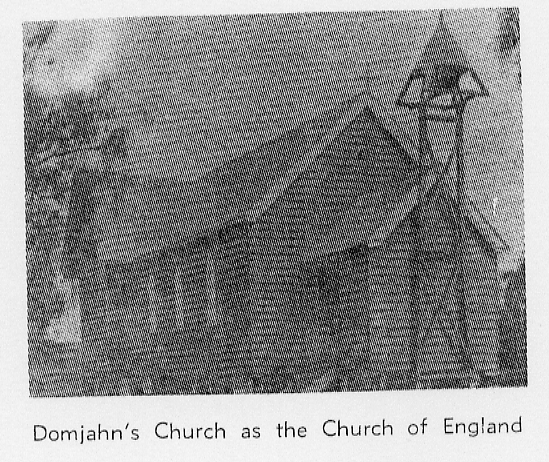
Th. Hebart comments, "Numerous churches
were built from plentiful timber, but they were not centrally
controlled and German individualism manifested itself in frequent
schism over trivial matters. Thus churches sprang up like mushrooms and
it was no uncommon sight to see two or three Lutheran churches in one
locality. Moreover shortage of pastors, too, permitted many
sectarian abuses to enter the Church. Laymen preached and even
women offered prayer in services." The United Evangelical
Lutheran Church in Australia" page 114.
This aptly describes the situation
pertaining to the Fassifern. But peculiar to the Fassifern was a well
organized and strongly motivated German Baptist movement which made
considerable impact on the Lutherans At that time the Fassifern would
have been at least 90/o German, fairly evenly divided between Baptist
and Lutheran. But the Lutherans
were also potentially divided among themselves. When in 1885 a Synod
was formed to try and unite the scattered congregations, that very same
year another one was formed, which split them down the centre.
While this is a history of hard
working pioneers attempting to come to grips with the problems of
setting up Church and community life it is also far more. It is
breath taking to see the way God overrules. Despite pressures and
trials, arguments and schisms, the Lord of the Church has brought
a peace and a unity which is amazing, and for which we praise
Him. It is with a sense of awe we note His guidance in the midst
of human clamour and division, as we piece together the history of the
past 100 years. This is the heritage of the present day St.
Johns Lutheran Church, Kalbar.
State Archives had more difficulty with it. His name, in the index to
the selectors, is recorded as Julius Domjaka. No wonder they wrote
back, unable to locate it! However, that doesn't alter the fact that on
7th July, 1875, he selected, what is described as 40 acres of
agricultural and 80 acres of first class pastoral land, portion 188A,
Parish of Fassifern, County of Churchill, and after having fulfilled
the conditions laid down, obtained the deed of grant on 10th October,
1881.
THE FIRST CHURCH BUILDING
It was on this ground that the
first Lutheran Church building was erected. An acre of land was
obtained, together with access, from what is now known as the Old
Kalbar Road. This building was erected by hard work and determination.
Despite problems, nothing was spared to make it durable and lasting.
The hard work included hand sawn timber
and a shingle roof. It was well built. This is attested by the fact
that it survives today after almost 100 years. It has been shifted
three times, on two sites as the Kalbar Church of England, and now as
the centre of a ranch type residence of Leon Cantrell, Obum Obum Road.
The shingle roof has long since been replaced by iron, excepting in the
porch, where
the original shingles are clearly visible under the iron.
This building was originally
dedicated by Pastor Ernst Heiner of Ipswich as St. Mark's Lutheran
Church, Fassifern. The date is not clear, but it would have been in
1881 or 1882.
Edward Iker liked to be where the
action was. In 1882 or 1883, he had bought portion 198, Parish of
Fassifern, County of Churchill, off C. E. Volkmann. In 1883 he paid 8/-
in rates. Significantly, the purchase of this property made him a
neighbour of Julius Domjahn. When he bought it, it had two slab huts on
it. But soon it was to have more buildings, a flour mill and a Church.
In the meantime he was involved with St. Mark's, coping with a problem
and looking forward to a big event in the life of this newly formed
congregation.
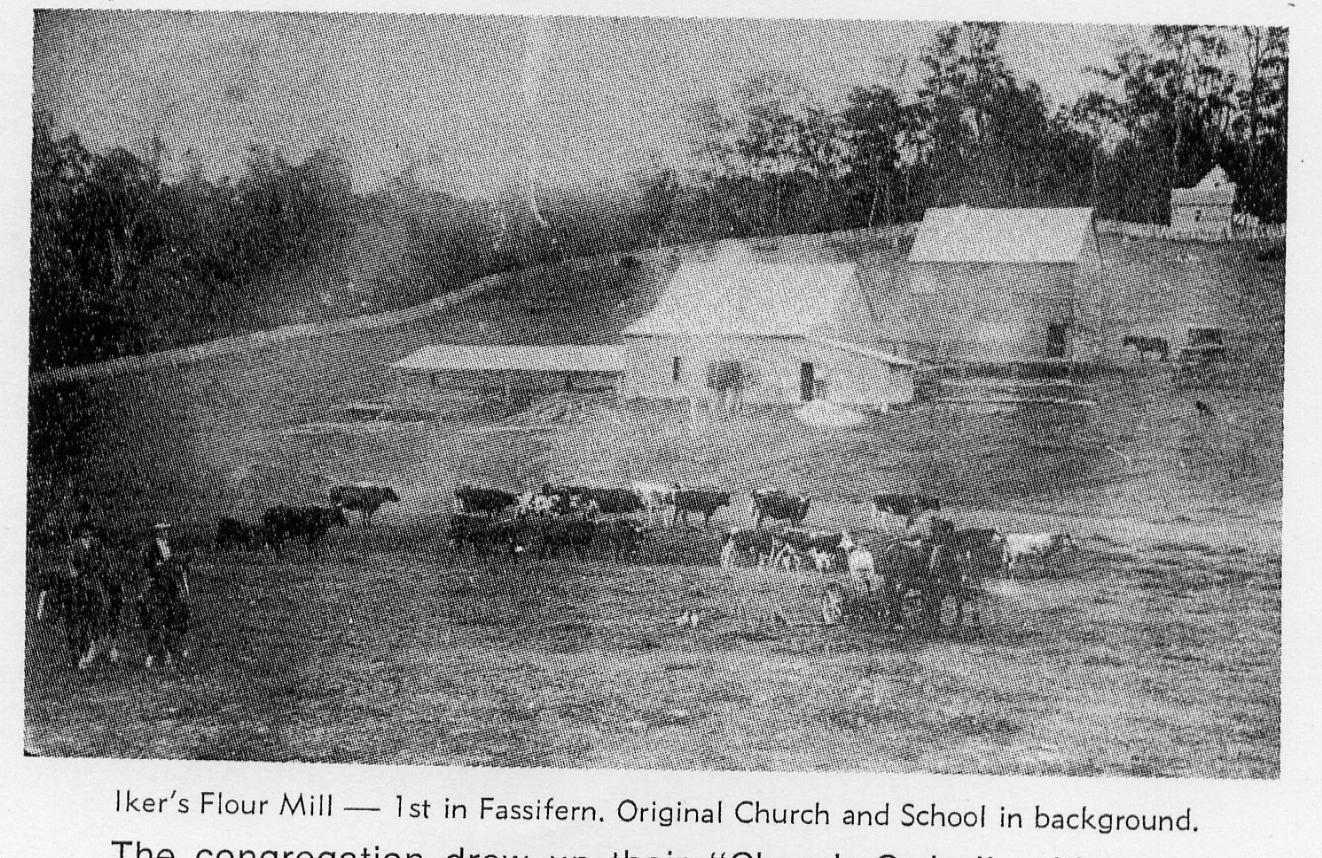
THE FIRST FASSIFERN LUTHERAN PASTOR
With the completion of the church
building came the more difficult task of providing regular preaching
services. Pastor Heiner was overtaxed and ordained preachers were a
scarce commodity in those days. However, J. F. R. Goessling, a former
missionary at Bethesda, Killalpaninna, S.A., who had been trained at
Hermannsburg Mission Seminary, Germany, and who was now stationed
at Kirchheim (Marburg), helped arrange for four young men from
Hermannsburg training centre to come to Queensland. They landed in
Brisbane on 12th March, 1883.
One of them, Pastor Conrad
Prenzler, was destined to be the first resident Lutheran Pastor in the
Fassifern. He was a young married man, aged 33 years. He had been
ordained on 16th October, 1882. This was to be his first parish. It
must have been with a certain trepidation that he and his wife and family-set
sail for another country. They arrived by way of Adelaide on 7th
January, 1883. On his arrival in Brisbane, he was duly registered to
perform marriages by the Registrar General on 16th March, 1883. The
form is still in the parish records. This authorization was also duly
recorded in the Queensland Government Gazette 1883, Vol. XXXII. These
have been photostated and published for their historic interest, pp 14
and
15.

Pastor Prenzler was duly installed
on Palm Sunday, 18th March, 1883. It must have been a day of special
rejoicing. In connection with this service, Elizabeth Elsa Emma
Sonnenburg, daughter of August Sonnenburg and his wife Emilie nee
Poelitz, of Fassifern Scrub, was baptized. She had been born on 16th
February 1883. God parents were Edward Iker and Bertha Poelitz. These
particulars, together with all his other pastoral acts, are clearly
recorded in a well bound book, embossed with gold lettering,
"KIRCHENBUCH der Evang. Lutherischen Kirche zu FASSIFERN."
In addition to the Fassifern
congregation he also served Hoya, then known as Dugandan, where he
lived in a manse provided near the church building. Thus he would seem
to
have been firmly established as the first Lutheran pastor in the
Fassifern district.
DIVISION
However, Pastor Prenzler's
ministry was soon to be plagued with divisive strife, which had been
smouldering in the Fassifern congregation even prior to the building of
the church. Obviously there had been some sort of reconciliation which
enabled the work to go ahead. But it was to erupt with frightening
vehemence. Earlier in 1885 there is reference
to some trouble over confirming children of non members. Then, in
August of that year, when two Synods were formed, some members objected
to Pastor Prenzler being a member of the United German and Scandinavian
Synod. On the 12th Sunday after Trinity they actually physically
prevented him from officiating at the altar. The following Sunday they
refused to allow him to enter the church grounds. He, together with
those who remained loyal to him, about half the congregation, proceeded
to the house of Edward Iker (the present Wittenhagen home). Here they
held regular worship services and meetings for the next two months.
ESTABLISHMENT OF ST. JOHN'S
These members formed themselves
into a congregation, St. John's. They decided to build another church
at a meeting on 14th September, 1885. It was noted that their numbers
had shrunk to 16 members. But they were able to raise £51/10/-
and were so unanimous in their desire to erect a new church building
that St John's was built and dedicated the very next month, on 28th
October 1885. Iker donated the ground, which is the site of the present
church building. Their sister congregation at Hoya generously
contributed £13/2/6 while firends from the Logan area gave
£7/16/-. ...
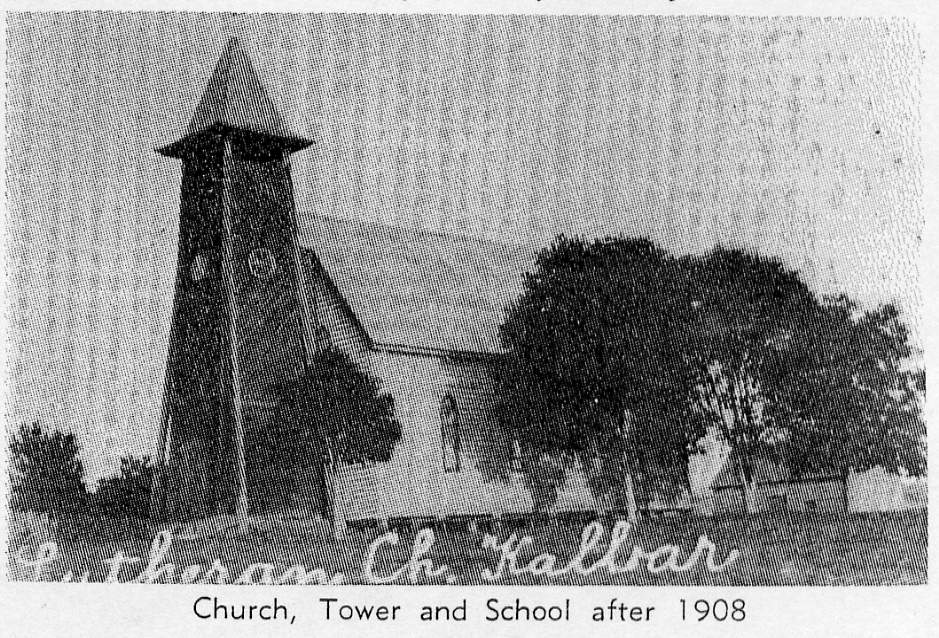
Domjahn's Cemetery
After the uniting of the three
congregations in 1900, and the construction of an enlarged St. John's
church building in 1901 to accomodate
the increasing number of worshippers, "Domjahn's" church became
redundant. It was closed and sold to the Church of England, Kalbar, for
£25. Ernie Wittenhagen was the last child to be baptized in it on
14th
March, 1901. The ground was then dedicated as a cemetery. It was used
for this until as late as 1945.
In keeping with his request,
Julius Domjahn was buried there and
the bell tolled for his funeral would have been clearly heard. He died
on 8th December, 1911 at the age of 65 and was buried the next day
by Pastor Monz, with H. Wittenhagen and C. Muller the witnesses. He
had been in Queensland for 39 years. It was 38 years previously that he
was first mentioned at Mutdapilly Reserve, in January, 1875, as a
financial
member. There he had contributed both to the new organ and the
extensions to the church building.
It was through his 'Will' that the
Archives were able to trace him.
For there his name was spelt correctly. They offered to make a copy of
the will for our research. The 49 pages of it cost us $4.90. Such were
the legal procedures of the early 1900's. The Will is simple enough and
dated 21st November, 1911. It was filed in the Supreme Court by C. W.
Louis Heiner, Pastor Heiner's son. One item of interest, "I give and
bequeath my gold watch and chain to the said Hermann Gustav Domjahn
absolutely." In the inventory it is stated to have a value of £5.
Today
it is still in the family, in the possession of his grandson Victor. It
looks
like new. Each link of the chain is stamped. The front of the watch is
embossed with a large "J.D.".
Clearly Julius Domjahn prospered
in the Fassifern, and the Lutheran
Church continued to prosper following the union. But there were some
difficult times when Pastor Frank left and the parish had no pastor.
Mutdapilly
The pressure for realignment in the early 1970's was resisted by
Mutdapilly. At a special meeting on 4th November 1973,
it was moved by B. Weber seconded by V. Ruthenberg "That realignment be
deferred as long as possible," carried.
However, the future was bleak for this congregation. The Sunday School
had closed. No children disturbed the services,
for parents with Sunday School children sought out other congregations.
The most likely one was St. Matthew's Harrisville,
which Pastor Lister commenced in late 1968, with a flourishing Sunday
School.
Also, it was a somewhat isolated spot, not signposted. When the
Parish Service was held there on November 5th 1975, there were members
of the Kalbar Parish who did not know where it was. Pastor Howard
Pohlner suggested that sign posts be erected and a noticeboard with
service times displayed. But this was declined. The fear was expressed
that vandals would be attracted. Back in 1940 a couple of windows had
been broken, but this had been done by local lads and their parents
were asked to help with repairs. Also an additional glass insurance was
taken out to cover the windows.
In 1976 Pastor Pohlner suggested that John Bowes, a parish worker, be
invited to help conduct an evangelistic visitation in the area in
conjunction with Harrisville. This was declined. A secret ballot was
held on 1st February 1976, which resulted in
seven votes for closure, six to remain open and one informal. After the
closing service, Palm Sunday, 11th April 1976, a meeting was held,
where a vote of thanks was moved to Pastor Bergmann for his translation
of the German minutes into English and a cash donation of $100 given in
recognition of his preaching services freely given since his retirement
to
Mutdapilly. The candlesticks were also given to him. The Communion set
was given to Harrisville. The church building and land was given to
Kalbar Parish, which in turn donated same to St. Matthew's,
Harrisville. Within three years the building was put to good use on a
new location.
Actually this congregation had clung on tenaciously through a difficult
time when farmers were moving to the city.
But by the time it closed the trend was reversed as city people were
moving to the fresh country air. While this congregation
had no Sunday School the local school was overcrowded. However,
the 107 year old Church was unable to take advantage of this
opportunity. Most of the members joined St. John's Ipswich, one family
Harrisville and one member, Kalbar. Throughout its life, this Church
had been something of a springboard to greener pastures as members
moved off.
Now even the church building was to be moved to a more central place to
serve the Harrisville community. It may have been the end of the
chapter, but not of the book.
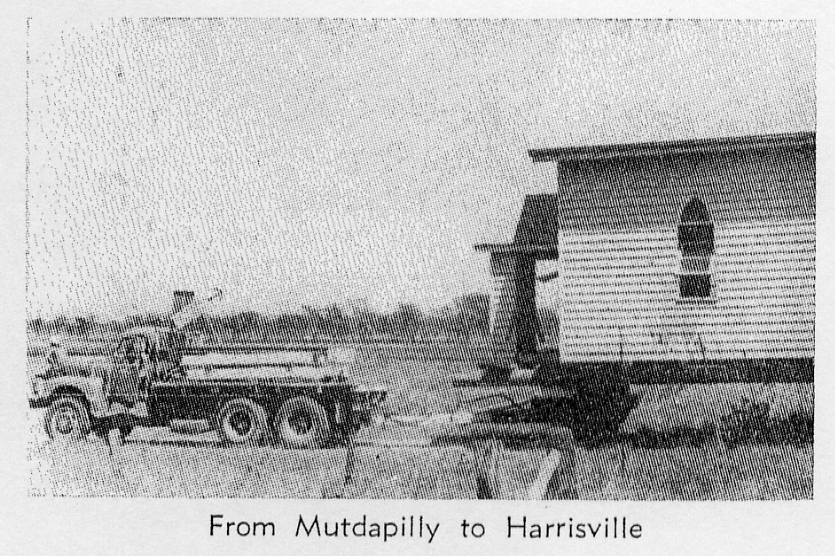
STATUTES FOR THE GERMAN EVANGELICAL LUTHERAN
CONGREGATION IPSWICH AGRICULTURAL RESERVE
A GENERAL
1. The name of this Congregation shall be, "Evangelical Lutheran
Church."
2. The main principles are: To form a unity which ties all
members together, to encourage each other, to support each other to
form a unity in spiritual matters concerning the Church.
3. The name of our Church is, "St. John's Church."
4. The day of dedication of this Church was, 29th March 1869. The
Church was dedicated by Pastor Ernst Heiner.
5. The "Church" comprises the church services and all church
performances and dives each one opportunity to have his (or her)
devotional exercises in the church, to strengthen and develop his faith
and to bring up young people to adult membership of the church.
6. Services will be held on all Sundays and all Festival days.
These will commence at 12 midday in the winter and 11 a.m. in the
summer.
7. The sermons shall be delivered by the preacher in memorised
form. If the preacher is hindered by sickness or other circumstances to
come, a member of the congregation shall read the sermon.
8. Voluntary gifts in collections after the service will be given
and the money will go into the church fund, as other income will too,
which will be superintended by the treasurer. If possible the income of
the collections should help pay the debts of the congregation.
9. Devotional performances include. Baptism, Confirmation,
Marriage, Confession and Holy Communion, Visiting the sick and Burials.
10. For ail these services the members pay the officiating preacher a
voluntary donation except for weddings, for which the preacher will
receive £2/10/-, and 10/- for Confirmations. But all non members
have to pay a certain tax, i.e. At Baptisms 5/- to the Pastor, but if
non members promise to become members and if they pay 6/- in advance
for the next half year, then they have not to pay the above mentioned
tax.
11. The salary of the Pastor will consist of a sum which the whole
congregation will aqree upon and should be paid monthly in advance.
ST. MATTHEW'S LUTHERAN CHURCH HARRISVILLE
St Matthew's Lutheran Church,
Harrisville, was formed as a congregation on the 21st March 1971, and
became part of the Kalbar Parish after having held regular services in
the Harrisville School of Arts Hall for three years, prior to this
date. Pastor Lister was Chairman and Mr. B. Schmidt was elected as
Secretary. Mr. C. Ernst was elected as Chairman
at the meeting held on the 30th May.
At a meeting on 11th March 1974, it was decided that the Chairman
enquire about a Church building in view of holding services in same.
Confirmation and Christmas services were held in the Presbyterian
Church. After several meetings and discussions refering to the
purchases of a Church building and block of land, Mr. Des Dull was
asked to look for a suitable building block. It was decided on 11th
September 1977, that a block of land in North Street, Harrisville, be
purchased as the site for a future church building to be erected.
Pastor Bergmann, who had purchased the Mutdapilly Church
building, offered it to the Harrisville congregation, for removal
to the site. This generous offer was gratefully accepted.
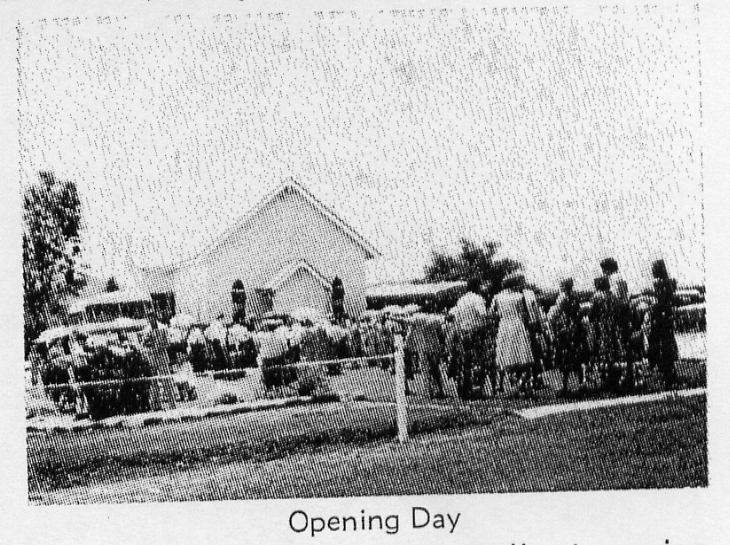
A motion was moved by the Church Council that the Queensland District
of the Lutheran Church of Australia be Trustees. The members of the
congregation became a hive of activity with the thought of having their
own Church to worship in. The ladies held street stalls to raise money.
After the Church had been moved on to the site in North Street, there
was the job of stripping and re-painting, which was done by voluntary
labour by the members who worked afternoons and weekends. A toilet
block was built. Landscaping for gardens and lawns was done and shrubs
and trees were planted.
The Church was opened on 3rd
December 1978, by Pastor Brian Lister who was responsible for the
forming of St. Matthew's congregation ten years earlier. The Church was
re-dedicated by President R. J. Mayer, President L. C. A.
Queensland District. Pastor Bergmann unveiled the plaque with the
following inscription, This Church was moved to Harris-
ville and re-dedicated to the Glory of God on 3rd December, 1978.' The
text from James 1:22, which hung over the altar in St. John's,
Mutdapilly, was inscribed on a timber plaque and hung in St. Matthew's.
It reads, "Be doers of the Word and not hearers only." The Church
on the move had become a reality and is growing in God's care, under
the guidance of Pastor H. Pohlner, elders, B. Schmidt and L Mocker,
with dedicated members, a Sunday School and a youth group.
HISTORY OF ST. LUKE'S LUTHERAN CHURCH, MILBONG
"When the Government threw open
the land in the Coulson-Milbong district it was mostly English people
who took it up. The heavy scrub proved a barrier too hard to overcome
so that many were glad to dispose of their land to Germans, who came
mostly from Walloon and Fernyview." So begins the report of the Golden
Jubilee of St. Luke's Lutheran Church
Milbong, 8th September 1935. The report continues, "With vigour and
endurance they applied themselves to the task of hewing a home out of
the dense scrub. They only had the bare necessities of life; an extra
Sunday suit was unknown to many; food was the plainest; luxuries could
not be indulged in."
ESTABLISHING A CHURCH
As these hardworking settlers
commenced life in a new country they also desired spiritual strength.
They gathered together around the Word of God. They met with
like-minded Christians in homes at Hoya. In 1882 a church building was
erected there, and a manse built alongside it. Pastor Conrad Prenzler
was installed in 1883. This was a time of rejoicing. But soon such
dissension arose that when two Synods were formed in 1885, part of the
congregation left, joining the Evangelical Lutheran Synod and called
Pastor Heiner to serve them. Worship was held in the home of Mr. A. F.
Badke on the Ipswich Dugandan road. Mr. Badke was a butcher, farmer and
served as district council member. As more German settlers arrived it
was decided to purchase an acre of land off Mr. Badke for £3, for
church and cemetery. W. Wendorf, H. Menge and E. Wieland were elected
elders and W. Pokarier, H. Wilken and H. Zillmann trustees.
Plans were drawn up for a building 20 feet by 30 feet with walls
11 feet high. The floor and shingle roof to be of hardwood, the rest to
be of pine. For this the congregation had £2/12/6 on hand. But no
worries regarding finances at Milbong! The 39 members contributed
£46 and friends gave £51/13/6. This enabled the trustees to
go ahead. The tender
of A. A. Schelbach for £105 was accepted and the building
proceeded promptly.
DEDICATION
This building, which could seat 100 people, was dedicated on 23rd
September 1885 by Pastor Ernst Heiner, assisted by Pastors C. F.
A. Shirmeister and E. 0. Maier. This congregation, known as St.
Luke's was destined to take a prominent role in the establishment
of the Lutheran Church in the Fassifern, especially in the
Milbong-Kalbar Parish. Original members included H. Menge, E.
Wieland, Ch. Rossow, C. Siedowski, F. Lankowski, H. Wilken, W.
Pokarier, W. Kucks, A. Lewald, C. Wenzel, J. Podlich, A. Badke,
H. Zillmann, F. Carl, H. Wendorf, F. Sommerfeld, H. Zieike, G.
Beitzei, F. Leu, G. B. Wiess, W. Rossow, C. Kaaden, D. Badke, F.
Draheim, C. Eggert, H. Badke, A. Kaatz, R. Laegel,
J. Steffens, A. Peck, L. Kamp, E. Raatz and W. Graes.
The closing service was held on 24th November. It was conducted by
Pastor M. D. Reuther. The address for the occasion was given by the
retired Pastor H. W. L. Prenzler. It was based on Proverbs 22:28,
"Remove not the ancient landmark which thy fathers have set," and 1
Corinthians 15:58, "Therefore, my beloved brethren, be ye steadfast,
unmoveable, always abounding in the work of the Lord, forasmuch as ye
know that your labour is not in vain in the Lord."
Such a crowd was present that they had to bring in extra seating.
REMOVAL OF BUILDING
The building and contents had been given to St. John's Kalbar. At a
later meeting the trustees were directed to transfer the land also and
the congregation of St. Luke's was officially disbanded.
The building was advertised for sale by tender but the response was so
poor that none was accepted. Eventually it was sold to Wayne Lankowski.
It was transported to Teviotville, cut down and made into a pleasant,
roomy dwelling. The leadlight windows, especially bought for the
Jubilee, have been acquired by St. John's Lutheran Church, Corinda.
They were thrilled to be able to obtain such windows to adorn their
sanctuary, an answer to their prayers.
TEVIOTVILLE (Cross of Christ) LUTHERAN CHURCH
Through a Church paper from the South, Mr. Heinrich Liekefett
of Teviotville, learned there was a Lutheran Synod in the
Southern States with the same views on doctrine as he believed
were correct. He contacted that Synod (it was later called the
"Evangelical Lutheran Church of Australia.") The result was that Pastor
Otto Nichterlein from the Downs commenced to conduct services in
1903 at H. Liekefett's home. A congregation was established on New
Year's Day, 1904. Present at this service were: Mr. and Mrs. H.
Liekefett and family, Mr. and Mrs. F. Richter and family, and Mrs.
Richter's parents Mr. and Mrs. W. Raeck. This congregation grew. In
1909 it was too big to have services in a private home, so a church
building was built on land donated by Heinrich Liekefett.
In 1915, a Parish was formed with Barney View and Helidon Serving the
congregation at this time was Pastor C. Hoff, who only remained as
Pastor during 1915 and boarded at F. Richter's.
In 1916, a parsonage was built for the new resident Pastor H. F. A.
Bode. Pastor Bode worked very successfully for 53 years, and at first,
travelled by push bike, horse and buggy with two horses, train, and
from 1927 a car. Four years after arriving, Pastor Bode married. His
wife Claire is well remembered as a music and singing teacher, and for
her beautiful singing voice.
With the uniting of the Lutheran Synods, Teviotville closed in
May 1969 on the 60th Anniversary of the church building. Teviotville
did not have to close on account of lack of membership or
attendance. The services were always very well attended right to the
last. The Teviotville Church building was used to enlarge our sister
congregation in Boonah.
The manse was given to Pastor and Mrs. Bode as a token of appreciation
for services rendered. Approximately half of the members joined St.
John's Kalbar.
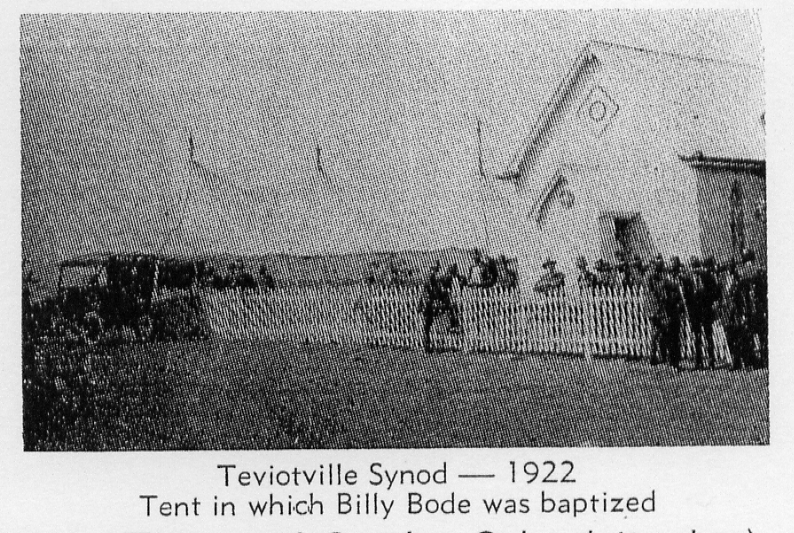
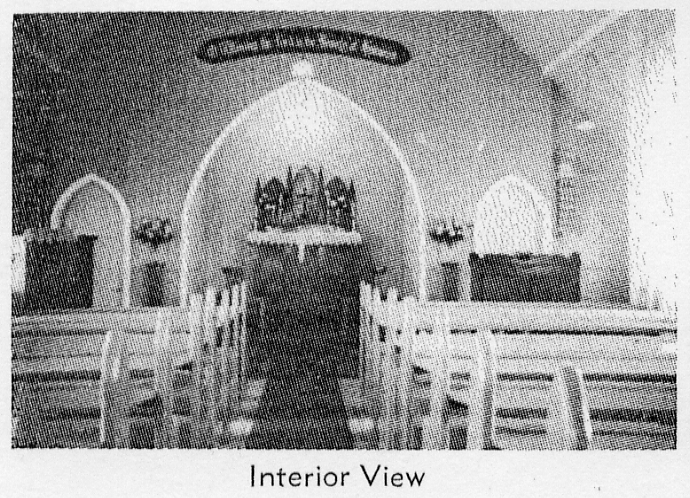
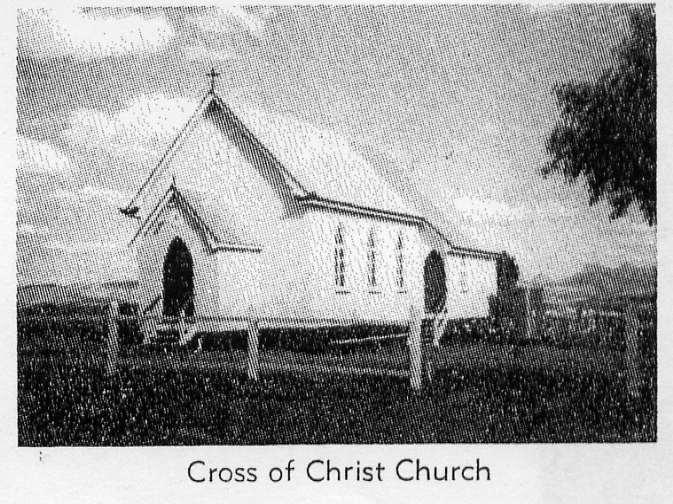
The Teviotville congregation was blessed with a talented choir. Those
who heard it will never forget the magnificent voices of Pastor and
Mrs. Bode, Frank and Rosie Hahn, Alf Bressow and others. The first
confirmation class comprised Ruth Maddox, Archie Freiberg and Eck.
Liekefett.
The first wedding was a triple celebration: Martha Liekefett marrying
Edward Stehn; Hermann Schuiz marrying Louise Marquardt and Clara Schuiz
marrying Richard Weber.
The first burial was Ottibiah Schuiz, who was buried by Heinrich
Liekefett in Hoya Cemetery. Some long serving members were: Heinrich
Liekefett, Fred Richter and Wilhelm Poelitz (German Lay Readers), Sir
Harold Richter (Secretary), Henry Walter (Treasurer), Reiny Liekefett
(Lay Reader — 39 years and Elder 23 years). Billy Bode (Organist — 31
years and
Sunday School teacher), Alt Schuiz (Elder and Sunday School teacher),
Frank Podlich (Secretary and Elder), Frank Hahn (Elder), Alt Bressow
(Elder), Bernie Schuiz (Secretary), Monica Liekefett (Organist and
Sunday School teacher), and Murray and John Freiberg (Youth Leaders).
HEINRICH FRIEDRICH ARMIN BODE
"The Lutheran" 18th December 1972
On August 9, 1886, a son was born to
Pastor Joachim G. E. Bode and his wife, Emilie, nee Appelt, at Dutton,
South Australia. He was Heinrich Friedrich Armin Bode.
He received his primary education
in the Lutheran day-school at Dutton, after which he went to work in a
general store at Nuriootpa. During this time he received a call from
God to become a Pastor of the Church. He enrolled at Concordia College
and Seminary in 1907, and remained there until 1915. He was ordained on
January 2, 1916, and was appointed to serve the Teviotville parish of
Queensland.
On February 17, 1920, Pastor Bode
married Clair Simon, of Adelaide and in 1927, when a family in his
congregation became orphaned, he and his wife fostered three of the
children: Alice, Bernie and Billy, Bernie predeceasing him in 1956.
The work in the Teviotville parish
necessitated a great deal of travelling — up to 10,000 miles a
year by rail alone, and until 1927, when a car was purchased, Pastor
Bode used a push-bike, a hack, and later buggy and ponies, to cover the
long distances. Among the places which he served were Teviotville,
Barney View, Glen Eagle, Ipswich, Helidon, Blenheim, Binjour Plateau,
Reid's Creek, Esk, Clarendon, and Mount Mort. When the Lutheran Synods
amalgamated, parishes were re-aligned, and Teviotville joined Boonah,
Kalbar and Miibong Congregations. Pastor Bode retired in 1969, having
created a record (in Queensland at least), by serving one parish
continuously for 53 years.
His fearless preaching had the
desired effect of convicting people of their sinfulness, and of sending
them fleeing for forgiveness and mercy to Jesus, their Lord and
Saviour.
Throughout his ministry, his childlike
faith and trust in his Saviour, and his unshakeable belief that every
word of the Bible is God's Word and cannot be altered, was evident
whenever he spoke.
One of Pastor Bode's greatest joys
was to sing God's praises, and his fine bass voice could always be
heard leading the singing. He often used to speak with excitement of
his anticipated joy of singing in heaven.
On June 10, his voice was silenced
by a stroke, which also left him partly paralysed. His condition
gradually became worse, until God graciously relieved him of his
suffering on November 23 at the Boonah Hospital.
At the funeral service at Boonah,
Pastor A. H. Koehler based his address on Ephesians 2:v 8, 9. Pastor J.
Perkins read the obituary, Pastor M. D. Reuther conducting the service.
President F. H. Schmidt officiated at the graveside in the Kalbar
Cemetery, on November 27th 1972.








